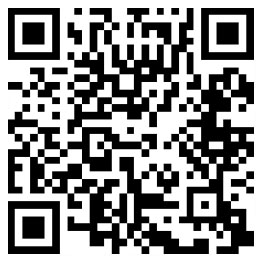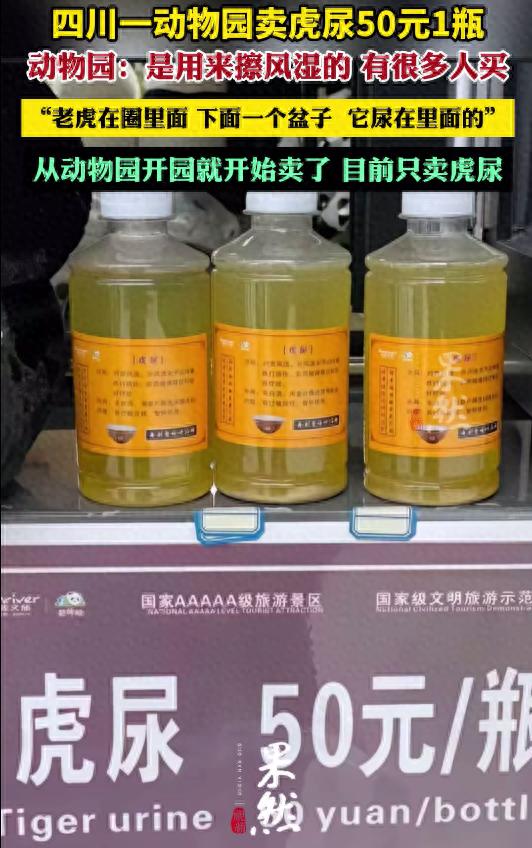The medicine sold at the pharmacy for 179 yuan is only sold for 126 yuan online! The patient scanned
Atorvastatin calcium tablets produced by the same manufacturer are sold at 179 yuan per box offline and 126 yuan online. Why is there such a big difference? If it weren't for the popularization of "drug traceability code", Mr. Chu from Xi'an, Shaanxi might never know the answer to this question.
The drug traceability code is the "electronic ID card" of the drug. According to relevant drug and medical insurance management regulations, a box of drugs can only be sold once, and the traceability code of a box of drugs should only have one record of being scanned by the final salesperson. If there are multiple scan records during the drug circulation process, there is a possibility of counterfeit drugs, "returned drugs" and drugs being sold interchangeably.
As a patient with high blood lipids, Mr. Chu, like many other cost-conscious patients, has the habit of buying blood lipid-lowering drugs online because he needs to take them regularly. On January 7, he selected a high-scoring store on an e-commerce platform, bought a box of atorvastatin calcium tablets, and received the medicine on the 12th. After scanning the drug traceability code with his mobile phone, Mr. Chu was surprised to find that he was the fourth person to scan the code. A day later, another scan record from Heilongjiang suddenly appeared .
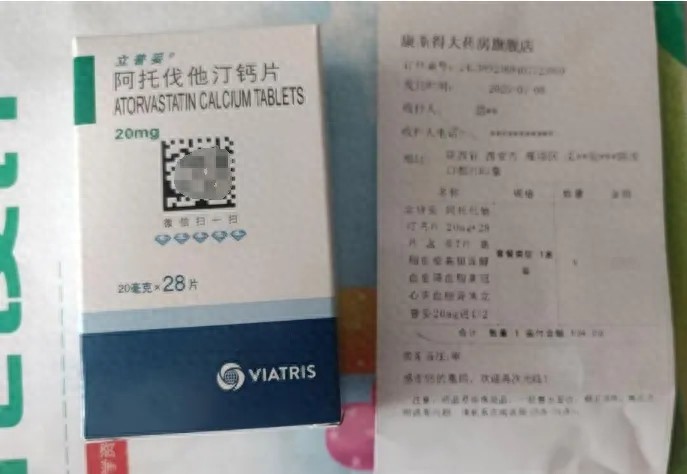
Image source: Provided by the interviewee
Since it is "one drug, one code", how can the drugs I bought have other people's scanned code records? Moreover, the addresses shown in several scanned code records span Shanxi, Shaanxi, Heilongjiang and other places. Even if I have already received the drugs, it still cannot stop someone from continuing to scan the code. What is going on? Mr. Chu is very puzzled.
There were three scan records before receiving it
The medicine you bought is not first-hand goods?
It is common knowledge among chronic disease patients that online medicine is cheaper than in physical pharmacies. However, after hearing too much about fake medicines, Mr. Chu is very careful when choosing merchants and basically does not buy medicines repeatedly in the same store. Previously, the lipid-lowering medicines he bought in this way looked exactly the same as those in physical stores. Before he scanned the code to verify it himself, most of the drug traceability codes had no scan records.
On January 7, Mr. Chu randomly selected a store with a high ranking based on the ratings, but this drug purchase experience taught him a lesson. The store Mr. Chu chose was called "Conside Pharmacy Flagship Store". Store information showed that when he bought atorvastatin calcium tablets, 71 people bought them in the store within 24 hours. When he received the medicine and scanned the drug traceability code, he found that he was the fourth person to scan the code.
In addition to Mr. Chu’s scan on January 12, the first three scans were on January 2, January 5, and January 11. The first scan showed the location as Wanbolin District, Taiyuan City, Shanxi Province. On January 14, Mr. Chu scanned the code again and found another scan on the 13th, showing the location as Daoli District, Harbin City, Heilongjiang Province.
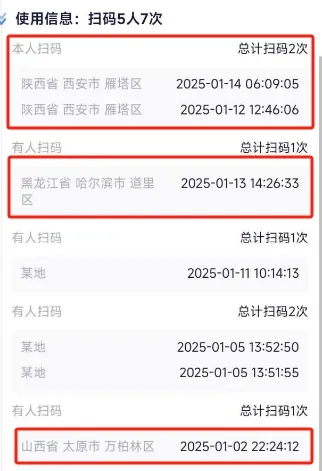
Image source: Provided by the interviewee
In this regard, the store customer service told Mr. Chu that "(drugs) need to be scanned when entering and leaving the warehouse, and those that can be scanned are genuine." The customer service also said, "If you mind, we can make a special application for you to ensure that the drugs are unopened." On January 12, Mr. Chu applied for a refund, but was rejected by the merchant. The other party believed that according to the Drug Law, drugs cannot be returned once they are out of the warehouse; according to the platform's after-sales rules, drugs are special products and do not support seven-day unconditional refunds. However, the merchant also said that it can be negotiated and refunds can only be made after the goods are returned.
As he was unable to determine the authenticity of the drugs, Mr. Chu refused to return the drugs and subsequently applied for the platform to intervene, but ultimately failed to successfully obtain a refund.
Mr. Chu told reporters that he did not accept the customer service's explanation that "drugs need to be scanned when entering and leaving the warehouse." "The traceability code is a one-time barcode that the end user verifies for authenticity. Is there any point in repeatedly verifying and scanning the code?" On January 13, he called the government service hotline where the pharmacy was located to report the problem. As of press time, Mr. Chu had not received any further response.
The reporter of "Daily Economic News" noticed that the company name shown in the store's qualification information is Jieyang Renmin Pharmaceutical Co., Ltd., and its business scope includes drug retail, etc. On the Black Cat Complaint Platform, two people had similar experiences as Mr. Chu, and the complaint times were March 12, 2024 and November 23, 2024 respectively.
Among them, one user bought three boxes of prescription drugs Lingruidan Lutongdu tablets in the store on August 20, 2023, worth 219 yuan, and received the drugs three days later. After checking the product traceability code, two boxes could not be found, one box of traceability code was queried and used multiple times, and one scan record occurred during the transportation of the drug; another user bought saw palmetto fruit extract soft capsules in the store on November 12, 2024. After multiple investigations and tracing by the manufacturer and supplier, it was determined that this batch of drugs was returned drugs from Jiangxi Hospital.
Manufacturer: Unable to determine product authenticity
Consumers have been cheated before
On January 19, the reporter called the public telephone number of Jieyang Renmin Pharmaceutical Co., Ltd., but the other party said that they did not understand the situation and needed to ask someone who knew the business; on the 20th, the reporter called twice, but no one answered. The WeChat account corresponding to the phone number accepted the reporter's friend request that night, but as of press time, the other party had not responded to the question of "returning drugs."
On the 20th, the reporter called Huizhi Pharmaceutical (Dalian) Co., Ltd., the manufacturer of the above-mentioned atorvastatin calcium tablets, as a consumer. The other party said that the company's products have "one box, one code" and there will be no duplication. If the traceability code of the online purchased medicine has been scanned by multiple people, the product may have quality problems or authenticity problems . In this case, even if the manufacturer checks the batch number of the drug, it is impossible to determine the authenticity of the product, because if there is a recycling of the medicine box or the printed medicine box, even if the medicine has a problem, the product batch number is correct. It is more accurate to judge the origin of the medicine by scanning the medicine traceability code record.
"Consumers may find that medicines are much cheaper online than in physical stores, and they may choose to buy them online. However, the Internet is not a formal channel to sell such products, and the purchasing channels may not be formal. They should try to buy them at larger local pharmacies ." The person said that other consumers had called the company before and said they had encountered similar situations. Some consumers had purchased multiple boxes of medicines online at one time, but "there was no place to recover the losses."
On January 20, the reporter called the e-commerce platform's customer service hotline as a consumer. The other party said that if it is a problem with the product, the platform will generally help consumers deal with it; if the merchant does not agree to a refund, they can apply for the platform to intervene separately.
So, when the drugs sold by merchants face authenticity disputes, what responsibilities should e-commerce platforms bear? Is the platform rule that "drugs are special commodities and do not support 7-day unconditional returns and exchanges" tenable?
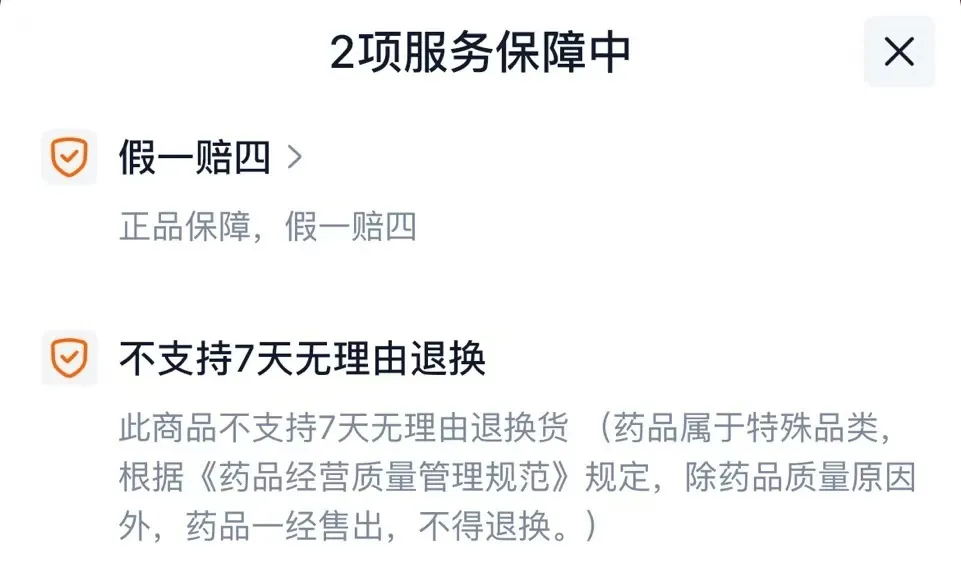
On January 20, Liu Dingrui, a lawyer at Sichuan Xinhexin Law Firm, said in an interview with the Daily Economic News that according to Article 173 of the "Pharmaceutical Business Quality Management Standards", there is indeed a provision that "except for drug quality reasons, drugs cannot be returned or exchanged once sold", but this does not mean that drugs cannot be returned or exchanged under any circumstances. The resale of "returned drugs" violates relevant drug and medical insurance management regulations .
In addition, according to Article 38 of the E-Commerce Law, if an e-commerce platform operator knows or should know that the goods sold or services provided by operators on the platform do not meet the requirements for protecting personal and property safety, or have other acts that infringe on the legitimate rights and interests of consumers, and fails to take necessary measures, it shall bear joint and several liability with the operators on the platform in accordance with the law. For goods or services that affect the life and health of consumers, if an e-commerce platform operator fails to fulfill its obligation to review the qualifications of operators on the platform, or fails to fulfill its obligation to ensure safety for consumers, causing damage to consumers, it shall bear corresponding liability in accordance with the law.
In other words, if there is sufficient evidence of "returning drugs", and the e-commerce platform does not respond to consumers' requests for returns, and consumers have personal problems after taking the drugs, the platform may bear joint liability with the pharmacies. In addition, if there is evidence that the e-commerce platform knowingly allowed the merchants to sell "returning drugs", it may also violate the criminal law .
Liu Dingrui believes that e-commerce platforms should effectively protect the rights of consumers in accordance with relevant regulations such as the E-Commerce Law and the Consumer Protection Law. It is "a violation of procedural justice" to hastily handle complaints on the grounds that "drugs are special commodities and cannot be returned or exchanged once sold" without fully listening to the statements of users and operators on the platform.
Is it "reflux medicine" or "brush set" or "empty brush"?
Industry insiders: Both are possible
The clerk of the physical drugstore told Mr. Chu that the price of 126 yuan per box on the e-commerce platform is lower than the purchase price of atorvastatin calcium tablets sold in his drugstore. The customer service center of the "Code on Peace of Mind" traceability platform told the reporter of the "Daily Economic News" that the drug traceability code is used to query drug information, "being scanned does not mean that there is any problem with the drug or not." "It (the drug) will flow through many distributors, and the distributors may also scan this code. I don't know what they scan this code for."
Mr. Chu questioned the explanation of the store customer service that "you need to scan the code to enter and leave the warehouse for medicines", "A box of medicine is stored in Shanxi, Shaanxi, and Heilongjiang. Isn't the shipping cost more expensive than the medicine itself?" In addition, he had received the medicine on January 12, and there was a new scan record on January 13. How to explain it? Did he buy "returned medicine" or was there something else going on? Mr. Chu wanted to find out.
On January 19, Huang Xiuxiang, former secretary general of the Hunan Pharmaceutical Distribution Industry Association, said in an interview with the Daily Economic News that during the circulation process, when distributors or pharmacies scan the code to sell drugs, it will not appear in the records of personal inquiry of the traceability code, so the claim of frequent "in and out of the warehouse" is untenable. According to relevant drug and medical insurance management regulations, a box of drugs can only be sold once, and the traceability code of a box of drugs should only have one record of being scanned by the final sales, so Mr. Chu is likely to have encountered "reflow drugs" .
Moreover, after Mr. Chu received the medicine, he still scanned the code in a different place the next day, indicating that there is still the possibility of "copying" or "empty scanning". The purpose of both is to defraud medical insurance funds. The difference lies in whether the drug seller actually provides medical services. The former replaces drugs with low medical insurance reimbursement ratios or drugs outside the medical insurance catalog with drugs with higher reimbursement ratios for scanning code sales, while the latter fabricates transaction records.
As for how merchants make money in the process of reselling returned drugs, the answer is "buy low and sell high". "China Medical Insurance" once reported in detail the main mode of reselling "returned drugs". For example, a drug priced at 100 yuan in the market only needs to be paid 20 yuan after medical insurance reimbursement. Drug dealers buy these partially reimbursed drugs from insured persons at a price slightly higher than 30 yuan, and then resell them to other buyers at 60 yuan, thus generating a lot of profit .
Huang Xiuxiang told reporters that some professional drug dealers have long been recycling medical insurance drugs around hospitals, mainly targeting patients with chronic diseases, special diseases, "old patients" who go to hospitals for treatment all year round, and even "fake patients." Drug dealers have formed a long-term profit chain by instigating patients to prescribe more drugs at medical insurance prices, recycling excess drugs, and then selling them through small pharmacies, clinics, private hospitals or online platforms. As long as there is a price difference in drugs, this reflux phenomenon may exist, and e-commerce platforms with imperfect supervision are the hardest hit areas for "reflux drugs."
Generally speaking, if no individual user scans the drug traceability code during this process, when the final consumer buys the drug, the traceability code queried will only show the record of the salesperson scanning the code once. But sometimes, the pharmacy owner also wants to determine whether the drug is "authentic" and will scan the code with his own account, thus leaving a record.
The responsibilities of third-party platforms have yet to be clarified
Drug traceability function still needs to be improved
Huang Xiuxiang said that the "buy low and sell high" profit chain of professional drug dealers has existed for many years, but since April 2024, when the National Healthcare Security Administration launched a pilot project to collect information on medical insurance drug and consumables traceability codes, efforts to promote drug traceability have been greatly strengthened, and many "insurance fraud" behaviors represented by drug substitution have been exposed.
For example, on November 2, 2024, the National Healthcare Security Administration's official WeChat account issued an announcement showing that some designated medical institutions had duplicate drug traceability codes when selling compound donkey-hide gelatin syrup reimbursed by medical insurance, and medical insurance fund settlements occurred in all of them. The duplications were greater than or equal to 3 times, involving 46 medical institutions in 11 provinces.
At present, the collection of medical insurance drug and consumable traceability code information is extending from the downstream links of the circulation chain to the upstream. On January 16, the National Medical Insurance Bureau held a release event for the collection and application of medical insurance drug and consumable traceability information. Fu Chaoqi, director of the National Medical Insurance Bureau's Big Data Center, said that production and distribution companies can upload three-code mapping association information, large, medium and small packaging cascade information, production link traceability information, circulation link traceability information, etc. through the national medical insurance information platform. Ultimately, the national medical insurance service platform will form full-chain information on drug and consumable traceability.
Huang Xiuxiang told reporters that at present, there are differences between domestic and foreign drug traceability systems. In China, according to the "Drug Traceability Code Coding Requirements" document, domestic drug traceability codes are mainly composed of four parts: drug identification code, production identification code, check digit, numbers, letters and (or) symbols. According to actual needs, the carrier of the drug traceability code can choose a one-dimensional barcode, a two-dimensional barcode or an RFID tag, etc., but a one-dimensional barcode can be easily copied or forged.
In foreign countries, taking the European Union as an example, each drug is given a unique QR code when it is produced. Although it is not mandatory to scan the code every time to record information during the circulation process, after the patient purchases the drug, the system will record that the drug has been sold and can no longer enter the circulation and use link. At present, the domestic drug traceability system does not have a similar function, but Huang Xiuxiang believes that it will definitely be supplemented in the future, that is, once the drug is sold in a medical institution, the system must record the sales information and display a warning: if the code is scanned again or other situations occur, there may be risks of counterfeit drugs, inferior drugs or reflux drugs.
Huang Xiuxiang also believes that the platform's statement that "no returns or exchanges after sales" is too simplistic in response to Mr. Chu's complaint and concerns about "buying fake drugs." In fact, the personal power of consumers is often limited, and third-party platforms have the responsibility to assist consumers and urge merchants to verify the problem and better respond to questions such as whether the drug traceability code being scanned by multiple people involves the scanning of dealers and whether it is "returned drugs."
As for Mr. Chu, on January 16, he saw that the National Healthcare Security Administration released an application for collecting information on medical insurance drug and consumable traceability, and downloaded the "National Healthcare Service Platform" App from the mobile application store. He inquired about the medical insurance drug/consumable traceability information for the atorvastatin calcium tablets he purchased from the e-commerce platform twice, and was reminded by the official that "the product is suspected of being sold multiple times."
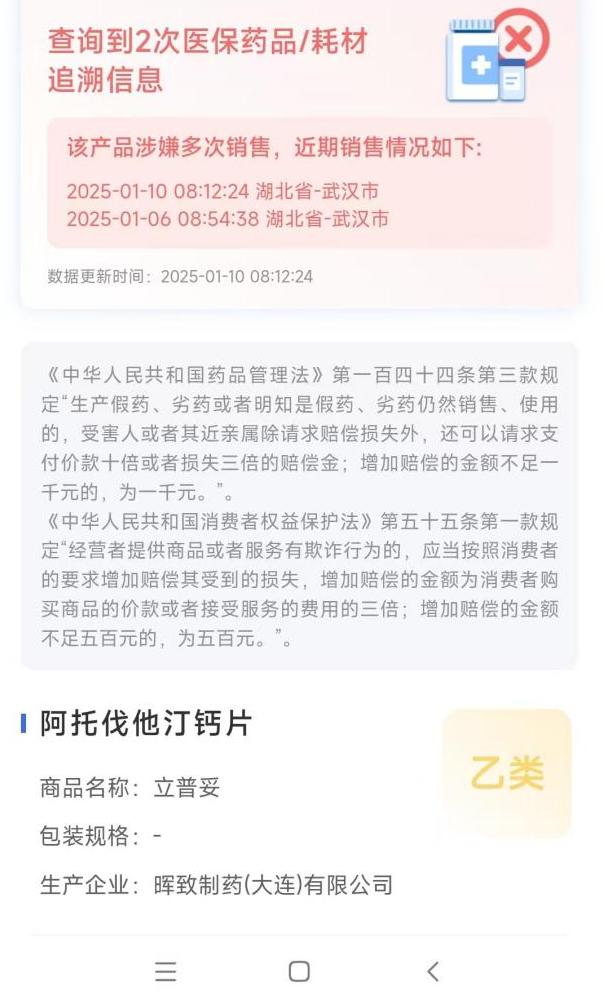
Image source: Screenshot of the "National Medical Insurance Service Platform"
The platform reminds that according to the first paragraph of Article 55 of the Consumer Protection Law, if an operator engages in fraudulent behavior in providing goods or services, he shall, at the request of the consumer, increase compensation for the losses suffered by the consumer, and the amount of increased compensation shall be three times the price of the goods purchased by the consumer or the cost of receiving the service; if the amount of increased compensation is less than 500 yuan, it shall be 500 yuan.
Source: Daily Economic News
Reporting and rights protection channels: Download the "Morning Video" client from the App Store, search for "report" and go directly to it; or add the reporting customer service on WeChat: xxcbcsp; or call the hotline 0731-85571188. If you need content cooperation, please call the government and enterprise service hotline 19176699651.
相关文章
- China's GDP will grow by 5% in 2024 to 18.41 trillion US dollars. Will the gap with the United State
- In 2000, the US GDP accounted for 25.68% of the world's total, while China only accounted for 3.02%.
- The gender imbalance of the post-00s has further intensified | Chinese men shouted: It’s finally our
- Special report on the stock market | Another divorce case with sky-high prices in the A-share market
- CSRC releases | State Council Information Office holds press conference: Introducing the situation o
- The global stock market is changing rapidly. A full analysis of the latest developments of A-shares,
- It has fallen again. Why can’t the Chinese stock market continue to rise?
- With the joint efforts of six departments, the stock market is about to usher in a "hundred-bil
- The real land of women: men don't marry and women don't marry, they climb through windows at night a
- The mysterious ethnic group in the mountains of my country has a special custom that is too scary. G


